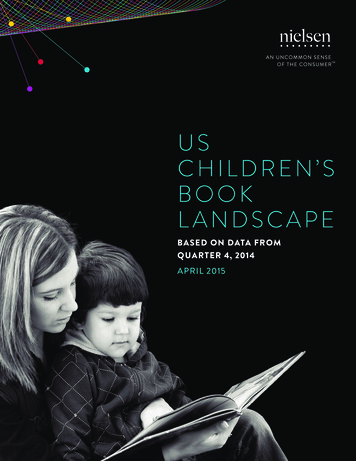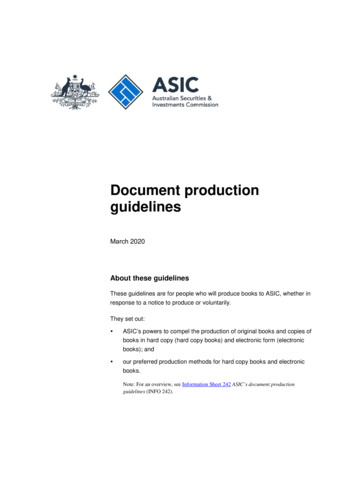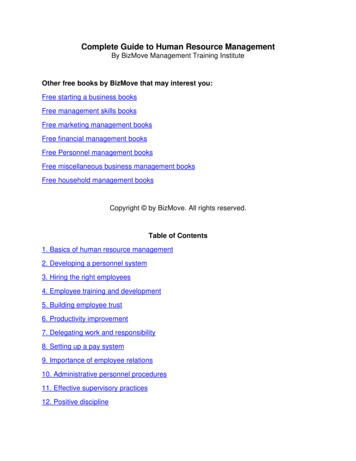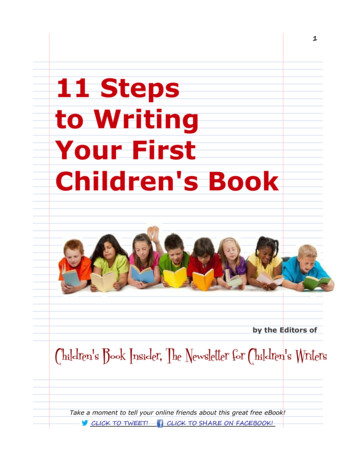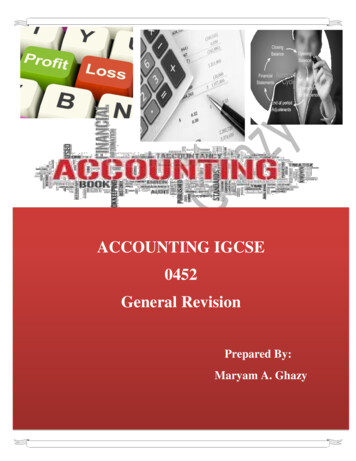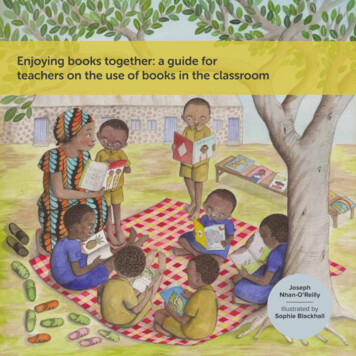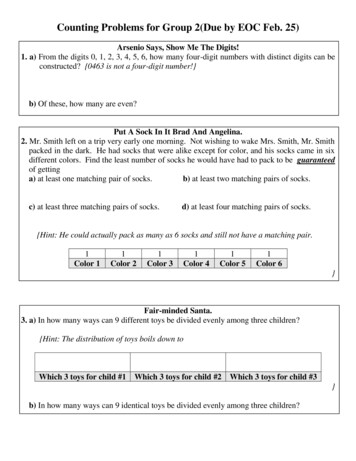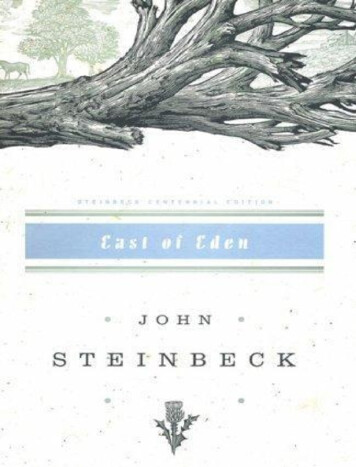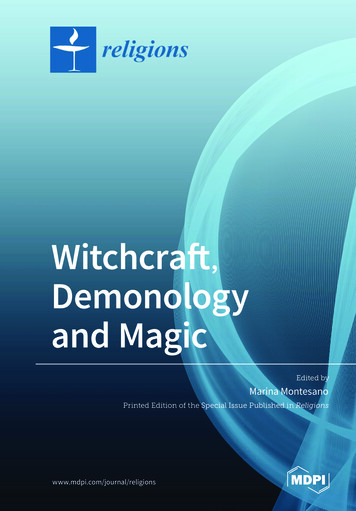
Transcription
Witchcraft,Demonologyand MagicEdited byMarina MontesanoPrinted Edition of the Special Issue Published in Religionswww.mdpi.com/journal/religions
Witchcraft, Demonology and Magic
Witchcraft, Demonology and MagicSpecial Issue EditorMarina MontesanoMDPI Basel Beijing Wuhan Barcelona Belgrade
Special Issue EditorMarina MontesanoDepartment of Ancient andModern Civilizations, Universitàdegli Studi di MessinaItalyEditorial OfficeMDPISt. Alban-Anlage 664052 Basel, SwitzerlandThis is a reprint of articles from the Special Issue published online in the open access journal Religions(ISSN 2077-1444) from 2019 to 2020 (available at: es/witchcraft).For citation purposes, cite each article independently as indicated on the article page online and asindicated below:LastName, A.A.; LastName, B.B.; LastName, C.C. Article Title. Journal Name Year, Article Number,Page Range.ISBN 978-3-03928-959-2 (Pbk)ISBN 978-3-03928-960-8 (PDF)c 2020 by the authors. Articles in this book are Open Access and distributed under the Creative Commons Attribution (CC BY) license, which allows users to download, copy and build uponpublished articles, as long as the author and publisher are properly credited, which ensures maximumdissemination and a wider impact of our publications.The book as a whole is distributed by MDPI under the terms and conditions of the Creative Commonslicense CC BY-NC-ND.
ContentsAbout the Special Issue Editor . . . . . . . . . . . . . . . . . . . . . . . . . . . . . . . . . . . . . . viiMarina MontesanoIntroduction to the Special Issue: Witchcraft, Demonology and MagicReprinted from: Religions 2020, 11, 187, doi:10.3390/rel11040187 . . . . . . . . . . . . . . . . . . .1Fabiana AmbrosiGiovan Battista Codronchi’s De morbis Veneficis ac Veneficiis (1595). Medicine, Exorcism andInquisition in Counter-Reformation ItalyReprinted from: Religions 2019, 10, 612, doi:10.3390/rel10110612 . . . . . . . . . . . . . . . . . . .4Fabrizio ContiNotes on the Nature of Beliefs in Witchcraft: Folklore and Classical Culture in Fifteenth CenturyMendicant TraditionsReprinted from: Religions 2019, 10, 576, doi:10.3390/rel10100576 . . . . . . . . . . . . . . . . . . . 20Ismael del Olmo“Such Fictitious Evil Spirits”: Adriaan Koerbagh’s Rejection of Biblical Demons and DemonicPossession in A Light Shining in Dark Places (1668)Reprinted from: Religions 2019, 10, 280, doi:10.3390/rel10040280 . . . . . . . . . . . . . . . . . . . 31Ildiko Sz. Kristof“Charming Sorcerers” or “Soldiers of Satan”?Witchcraft and Magic in the Eyes ofProtestant/Calvinist Preachers in Early Modern Hungary †Reprinted from: Religions 2019, 10, 328, doi:10.3390/rel10050328 . . . . . . . . . . . . . . . . . . . 46Debora MorettiAngels or Demons? Interactions and Borrowings between Folk Traditions, Religion andDemonology in Early Modern Italian Witchcraft TrialsReprinted from: Religions 2019, 10, 326, doi:10.3390/rel10050326 . . . . . . . . . . . . . . . . . . . 67Helen Parish“Paltrie Vermin, Cats, Mise, Toads, and Weasils”: Witches, Familiars, and Human-AnimalInteractions in the English Witch TrialsReprinted from: Religions 2019, 10, 134, doi:10.3390/rel10020134 . . . . . . . . . . . . . . . . . . . 84Vincenzo TedescoTreasure Hunt—Roman Inquisition and Magical Practices Ad Inveniendos Thesauros inSouthern TuscanyReprinted from: Religions 2019, 10, 444, doi:10.3390/rel10070444 . . . . . . . . . . . . . . . . . . . 98Rita VoltmerDebating the Devil’s Clergy. Demonology and the Media in Dialogue with Trials (14th to17th Century)Reprinted from: Religions 2019, 10, 648, doi:10.3390/rel10120648 . . . . . . . . . . . . . . . . . . . 109Francis YoungThe Dissolution of the Monasteries and the Democratisation of Magic inPost-Reformation EnglandReprinted from: Religions 2019, 10, 241, doi:10.3390/rel10040241 . . . . . . . . . . . . . . . . . . . 141v
About the Special Issue EditorMarina Montesano is full professor of Medieval History at the University of Messina, Italy.She obtained a PhD in Medieval History from the University of Florence and has been a visitingscholar at the Centre d’Études Supérieurs de Civilisation Médiévale in Poitiers and at BrownUniversity in Providence, RI, and has obtained fellowships at the Accademia della Crusca (Florence)and Villa I Tatti, The Harvard University Center for Italian Renaissance Studies in Florence.She is a member of the Association pour le Développement de l’Histoire Culturelle (ADHC) and,since September 2018, member of the Committee of the International Society for Cultural History(ISCH). Among her publications: Classical Culture and Witchcraft in Medieval and Renaissance Italy,London, Palgrave/MacMillan, 2018.vii
religionsEditorialIntroduction to the Special Issue: Witchcraft,Demonology and MagicMarina MontesanoDepartment of Ancient and Modern Civilizations, Università degli Studi di Messina, 98168 Messina, Italy;marina.montesano@unime.itReceived: 2 March 2020; Accepted: 3 April 2020; Published: 14 April 2020Witchcraft and magic are topics of enduring interest for many reasons. Chief among these is theirextraordinary interdisciplinarity: anthropologists, folklorists, historians, and more have contributed tobuild a body of work of extreme variety and consistence. Of course, this also means that the subjectsthemselves are not easy to assess. In a very general way, we can define witchcraft as a supernaturalmeans to cause harm, death, or misfortune, while magic also belongs to the field of the supernatural,or at least esoteric knowledge, but can be used to less dangerous effects: such as for divination andastrology. In Western civilization, however, the witch hunt of Late Medieval–Early Modern times hasset a very peculiar perspective in which diabolical witchcraft, the invention of the Sabbat and thepersecution of many thousands of (mostly) female and (sometimes) male presumed witches, gaveway to a phenomenon that is fundamentally different from traditional witchcraft, even if many casestudies conducted in South America or Africa present similarities, especially in contemporary times(see Wachtel 1992; Geschiere 1997). Another peculiarity of magic and witchcraft in Western civilizationis given by the number of writings that detailed their nature, techniques, and effects: these includetechnical treatises about how to perform magic, such as in the case of necromancy (see Kieckhefer 1998;Gal et al. 2017), or the many writings explaining the powers of witches from the point of view of judgesand inquisitors.Today, scholars generally agree on the so-called “cumulative concept of Western witchcraft”,meaning that, if there is one thing of which recent scholarship about witch hunting has assured us, itis that all mono-causality theories must be ruled out, as so many factors have been discovered andinvestigated: the change in climate, which occurred around the year 1600, and its socio-economic fallout(Behringer 1997: Id., Behringer 2009); the scientific debate that framed many of the phenomena relatedto witchcraft (Clark 1997); the social conditions in village communities and how often bottom-uppressure gave way to trials against alleged witches (Briggs 2002); the reading of folk beliefs inlight of heretical prosecutions and demonology (Kieckhefer 1976); the centrality of demonology(Ostorero 1995; Boureau 2004); and the role of humanistic culture in the developing of witch hunts(Montesano 2018). All of these, and many other approaches, have proven very useful for understandingwitch hunts, but only as pieces of a puzzle.This Special Issue of Religions dedicated to witchcraft, demonology, and magic features ninearticles that deal with four different regions of Europe (England, Germany, Hungary, and Italy) betweenLate Medieval and modern times in different contexts and social milieus. Far from pretending to offer acomplete picture, they focus on some topics that are central to the research in those fields. The roleof monks and priests in performing occult sciences and ritual magic is analyzed by Rita Voltmer(Debating the Devil’s Clergy. Demonology and the Media in Dialogue with Trials. 14th to 17th Century) ina long and articulated essay that takes into account the polemics between Catholics and Protestantsin Germany, while Francis Young (The Dissolution of the Monasteries and the Democratisation of Magicin Post-Reformation England) focuses on the role of friars and monks in England before and after thedissolution of monasteries (1536–1540), which of course provided a turning point in their role asmagic performers. Friars, especially Franciscan and Dominican preachers and inquisitors, and theirReligions 2020, 11, 187; ions
Religions 2020, 11, 187understanding of the witchcraft phenomenon are central in Fabrizio Conti’s article (Notes on the Natureof Beliefs in Witchcraft: Folklore and Classical Culture in Fifteenth Century Mendicant Traditions), this timeseen from the point of view of a history of ideas. Fabiana Ambrosi (Giovan Battista Codronchi’s Demorbis Veneficis ac Veneficiis—1595. Medicine, Exorcism and Inquisition in Counter-ReformationItaly) and Ismael Del Olmo (“Such Fictitious Evil Spirits”: Adriaan Koerbagh’s Rejection of BiblicalDemons and Demonic Possession in A Light Shining in Dark Places—1668) deal mainly with a historyof ideas, concentrating their attention on two intellectuals: Giovan Battista Codronchi, a key figure ofsixteenth-century medicine and Adriaan Koerbagh, exponent of the early Dutch Enlightenment, whosethinking is related to Thomas Hobbes. Many among the contributors deal with popular magic andbeliefs or with the circulation of ideas in different social and cultural tiers. This is the case for HelenParish (“Paltrie Vermin, Cats, Mise, Toads, and Weasils”: Witches, Familiars, and Human-Animal Interactionsin the English Witch Trials), who explores the vast domain of beliefs related to the metamorphosis ofdemons and witches in English trials, as well as for Vincenzo Tedesco (Treasure Hunt—Roman Inquisitionand Magical Practices Ad Inveniendos Thesauros in Southern Tuscany) who studies archival sources lookingfor a practice, that of magical treasure hunts, which has a long and complicated history. Similar toTedesco, Debora Moretti (Angels or Demons? Interactions and Borrowings between Folk Traditions, Religionand Demonology in Early Modern Italian Witchcraft Trials) devotes her study to central Italy and theRoman Inquisition’s trials dealing with folkloric magic. Ildiko Sz. Kristof (“Charming Sorcerers” or“Soldiers of Satan”? Witchcraft and Magic in the Eyes of Protestant/Calvinist Preachers in Early ModernHungary) gives an account of a topic not well known outside of Hungary: the definitions of witchcraftin Protestant/Calvinist preachers as read in Hungarian sources.As a whole, those articles, some of them provided by young scholars at the beginning of theircareers, show the variety of approaches as well as the vivacity and richness of current historiography andfit well within the current debate, suggesting that the puzzle of studies about witchcraft, demonology,and magic still needs many pieces to give us a better understanding of these multifaced phenomena.Funding: This research received no external funding.Conflicts of Interest: The author declares no conflict of interest.ReferencesBehringer, Wolfgang. 1997. Witchcraft Persecutions in Bavaria: Popular Magic, Religious Zealotry and Reason of State inEarly Modern Europe. Cambridge: Cambridge University Press.Behringer, Wolfgang. 2009. A Cultural History of Climate. Cambridge: Polity.Boureau, Alain. 2004. Satan hérétique: Naissance de la démonologie dans l'Occident medieval. 1280–1330. Paris:Odile Jacob.Briggs, Robin. 2002. Witches and Neighbors: The Social and Cultural Context of European Witchcraft. Oxford:Wiley-Blackwell.Clark, Stuart. 1997. Thinking with Demons: The Idea of Witchcraft in Early Modern Europe. Oxford: OxfordUniversity Press.Gal, Florence, Jean-Patrice Boudet, and Laurence Moulinier-Brogi. 2017. Vedrai mirabilia. Un libro di magia delQuattrocento. Roma: Viella.Geschiere, Peter. 1997. The Modernity of Witchcraft: Politics and the Occult in Postcolonial Africa. Charlottesville:University of Virginia Press.Kieckhefer, Richard. 1976. European Witch Trials: Their Foundations in Popular and Learned Culture, 1300–1500.London: Routledge.Kieckhefer, Richard. 1998. Forbidden Rites. A Necromancer’s Manual of the Fifteenth Century. University Park: PennState University Press.Montesano, Marina. 2018. Classical Culture and Witchcraft in Medieval and Renaissance Italy. London:Palgrave/Macmillan.2
Religions 2020, 11, 187Ostorero, Martine. 1995. Folâtrer Avec Les Démons. Lausanne: Cahiers Lausannois d’histoire médiévale.Wachtel, Nathan. 1992. Dieux et Vampires—Retour à Chipaya. Paris: Seuil. 2020 by the author. Licensee MDPI, Basel, Switzerland. This article is an open accessarticle distributed under the terms and conditions of the Creative Commons Attribution(CC BY) license (http://creativecommons.org/licenses/by/4.0/).3
religionsArticleGiovan Battista Codronchi’s De morbis Veneficis acVeneficiis (1595). Medicine, Exorcism and Inquisitionin Counter-Reformation ItalyFabiana AmbrosiDepartment of History, Cultures, Religions, Sapienza University of Rome, 00155 Rome, Italy;fabiana.ambrosi@uniroma1.itReceived: 5 September 2019; Accepted: 28 October 2019; Published: 4 November 2019Abstract: The physician Giovan Battista Codronchi (1547–1628) is a key figure of sixteenth-centurymedicine. A study of his main work De morbis veneficis ac veneficiis (1595) and his letters sent tothe Congregation of the Index in Rome (1597) can teach us much about the interrelation betweenmedicine and religion in Counter-Reformation Italy. Using Codronchi as a prism, this article uncoversa complex picture in which themes such as the production of demonological texts at the height of theEuropean witch-hunt, the related debate about the roles of physicians and exorcists, and the influenceof physicians on the development of the Index of Forbidden Books are interrelated.Keywords: medicine; demonology; gynecology; inquisition; censorship; counter-reformation ItalyIn 1595, the physician Giovan Battista Codronchi published the treatise De morbis veneficis acveneficiis (On Poisoning Diseases and Poisoners). Although Codronchi described the text as anaccidental result of his reflections on the diabolical illness that struck his daughter Francesca, itrepresented a crucial step taken by Codronchi in order to participate in the religious policies of theCatholic Church. A couple of years later, Codronchi sent a letter to the Congregation of the Index inRome containing a lengthy list of medicine books to be expurgated (Baldini and Spruit 2009, pp. 607–19).If we read the two sources together, Codronchi’s project of bringing medical and religious orthodoxyinto communication with each other and to the attention of authorities in Rome, becomes clear.Indeed, long before the possession of little Francesca, Codronchi had already played a leadingrole in the political and religious life of the city of Imola. He was nominated commissioner for thefinances (1590) and “ensign bearer” (1590). Even before that, Codronchi had been nominated to thecommission appointed to oversee the establishment of the Jesuit college in Imola (1581). Together withhis brother Tiberio, Codronchi was a key figure in the project. (Ferri 1997, p. 37) Moreover, whena medical meeting was assembled in Imola in 1591 in order to discuss how to deal with the plague,Codronchi was absent due to health reasons. But he sent the city council a document so to make hiscontribution: in order to “preserve the city of Imola from all bad and contagious evil” he proposed to“begin with spiritual commissions” (Mazzini 1924, p. 6).His political commitment always proceeded hand in hand with his faith and his medical profession,and the letter he sent to the Congregation of the Index constituted the very peak of his attempts tocreate a direct connection with Rome.The religious behavior of early modern Italy was marked by a peculiar intertwining of popularmagic, religion and of the consequent repression of dissent. (Ginzburg 1966, 1989; Romeo 1990, 2008b;Di Simplicio 2005). Already in the Middle Ages jurists, theologians and philosophers questionedthe power of Satan and the possibility of his action in the physical world. But it is in the EarlyModern period, in the midst of the great European witch-hunt, that demonology emerged as a coherentdiscourse which systematized beliefs about the demonic (Clark 1997b). Although skeptical voicesReligions 2019, 10, 612; ions
Religions 2019, 10, 612about the witches’ powers were already present at that time—and indeed, they predated belief—dissentactually encouraged the continuation of the debate between the supporters of persecution and the“witches’ advocates” (Valente 2008; Machielsen 2011; Duni 2012, 2016). In Italy, it was originallyinquisitors—especially Dominicans, as the author of the Malleus Maleficarum had been—who ledthe way in confronting the problem of witchcraft in print (Tavuzzi 2007; Romeo 2008a; Herzig 2008,2017). Yet, the second half of the sixteenth century saw a noticeable shift in authorial production, withexorcists and physicians dominating the market (Lavenia 2011). This unusual state of affairs may havebeen due to the fact that witch-hunting in Italy did not reach anywhere near the dimensions witnessedin many other parts of Europe (Levack 2006; Monter 2006).The institution of the Roman Inquisition (1542) certainly had a considerable impact on this process,since it represented a unitary bond within a territory that was otherwise politically and sociallyunconnected (Romeo 2002; Brambilla 2006; Prosperi 2006; Mayer 2014). From its headquarters in Rome,the Inquisition coordinated courts across the peninsula (Aaron-Beller and Black 2018). It managed tolimit the operational liberties of the local dioceses by establishing specific provisions for witchcraft(Tedeschi 1990). It thus prevented the recurrence of the violent anti-witches campaigns that hadoccurred in northern Italy at the end of the fifteenth century and at the very beginning of the sixteenthcentury (Prevideprato 1992). The Inquisition’s original focus on stemming the spread of Protestantheresy and strengthening papal authority over the Council might well explains its skeptical attitudetowards witchcraft.Only in the 1570s, when the threat of heresy had subsided, did the Holy Office begin to paymore attention to witchcraft as part of a wider struggle against superstition which culminated in thepromulgation of the bull Coeli et terrae (1586) by Pope Sixtus V (Ernst 1991). Yet, even then, the officialapproach towards witchcraft was less than clear-cut and the bull likely inadvertently led to a furtherdecline in the number of trials (Bever 2009). Because Coeli et terrae invalidated the distinction betweensimple and heretical magic, it deprived diocesan courts of their remaining jurisdiction in witchcraftcases. This step towards further centralization represented a turning point in the management of ‘thesupernatural’ in Italy, since it reaffirmed Rome’s exclusive control over the supernatural, the sacred,and legitimate rituals, all of which were threatened by popular practices, especially in the realm ofhealing and medicine (Valente 2015; Donato 2019).As a part of the battlefield between bishops and inquisitors over jurisdictional competence, localexorcists—in their voluminous publications—often blamed the spread of witchcraft on the excessivecautiousness of inquisitors and managed to give their contribution (Romeo 1990; Dall’Olio 2001a,2001b). Exorcism manuals circulated mostly among the clergy, aimed to help the priests to identify andconfront demonic manifestation (Caciola 2003), filling the vacuum created by perceived institutionalinaction. Inevitably, such individual enterprising by local priests made fears of witchcraft and demonicpossession worse, even in some of Italy’s major cities. It is no coincidence, therefore, that most exorcismmanuals were ultimately included, along with some of the European demonological treatises, in severalIndexes of Forbidden Books, albeit not until the early eighteenth century (Lavenia 2005; Brambilla2010, p. 79; Valente 2012). When the boundary between heresy and orthodoxy proved both malleableand very easy to cross, this sort of priestly do-it-yourself literature left too much space for actionsfrom below (Romeo 1990, p. 113). In this respect, Codronchi’s De morbis veneficis seems to be preciselyhalfway between ecclesiastical concerns and exorcists’ intentions. As a learned man, he could beproperly included among Italian demonologists such as Girolamo Menghi or Silvestro Mazzolini,founders of early modern Italian exorcist literature. Yet, in contrast to other authors, witch-huntingwas not Codronchi’s concern and indeed, neither in his treatise nor in the archives can one find anyproof of Codronchi’s attempt to legally pursue the person alleged to have bewitched his daughter.11In the inquisitorial records kept in the diocesan archives of Imola, Busta 1 of the Series Processi contains three Registers,which, in total, contain the trial papers from 1551 to 1595. From the published inventory (Ferri 2001) appears that Register 3opens with the trial of 8 January to Ioseph de Cremona with the accusation De propositionibus, as well as from the manuscript5
Religions 2019, 10, 612Codronchi’s De morbis veneficis represents a major contribution by a physician to the early moderndemonological debate. Codronchi opens the work by expounding its autobiographical origins. Hisdaughter Francesca was only ten months old when she suddenly began to lose weight. The childhad been entrusted to a wet nurse, but in a short space of time, she grew thin and started whiningincessantly. She cried constantly, much more than children normally do at her age. Her symptomswere not recognized as a known illness and consequently, the child’s conditions continued to worsen.Gradually, Irene Teodosi, her mother, began to suspect that someone had put a spell on her child,moved by hatred or envy. Objects often associated with witchcraft were found in the infant’s cradle,including peas, grains of coriander, a chip of apparently human bone, and even some sort of bloodlump described as being made of the menstrual blood of a devilish woman. Thoroughly alarmed, theparents got her wet nurse dismissed and entrusted the child to an experienced exorcist. After threedays, she showed signs of improvement. Before she was entirely cured, however, the child relapsed,and again, strange objects were found in her cradle. In the end, however, the exorcist managed toheal her.2With the publication of the De morbis veneficis, a work influenced not only by personal experiencebut also by European demonology and by manuals for inquisitors and exorcists, the devil entersCodronchi’s medical analysis. However, after explaining the reasons that led him to take an interestin the diabolical, he took care to state that “the malefice was probably allowed by God himself, inorder to experience in my own daughter what in others I would have hardly believed to be true”.3Thus, he takes personal responsibility for his daughter’s illness and also avoids to fall into the trap ofdualism—a perennial problem for demonologists—but rather emphasizes the primacy of God evenin his daughter’s possession episode. This was, indeed, a common approach in all demonologicalanalyses, since Christian authors needed to avoid any implication of Manichean dualism by statingthat diabolical forces act only with God permission (Cameron 2010).Although unexpected from the perspective of northern demonology, the De morbis veneficis fitsperfectly within the typically Italian demonological literature (Tavuzzi 1997; Maggi 2001, 2006; Valente2003; Lavenia 2011; Machielsen 2015; Dall’Olio 2018). However, what makes the text particularlyinteresting is that it is among the first contributions to be authored by a physician. Within the Italiandemonological debate, dominated by Inquisitors and exorcists, physicians were often criticized. Theidea that the occult played a role in the physical world was by then established and shared, and theinefficiency of official therapies was proof of this (Clark 1997a; Lavenia 2013). Thus, the significance ofthe De morbis veneficis is the way that its author sought to bring these two disciplines together in theservice of Tridentine reform.Despite its autobiographical origins, the structure of the De morbis veneficis resembles that of otherdemonological texts. Divided into four volumes, the first surveys source from antiquity. Biblical andthen patristic sources are followed by the most authoritative sources in the fields of medicine and23inventory on the folders. Actually, the register begins from page 61, and the first available trial is the one against MaddalenaValgo la Fenzarola, on 17 March of the same year. Among the lost papers there are also the trials with accusation De sortilegisagainst Francesca Brocardi (17 February) and Giulio Segantino (20 February). In light of the date of the trial, Brocardi couldhave been the most plausible wet nurse of Francesca Codronchi, suspected and fired, but without the papers it is impossibleto ascertain. Going backwards chronologically, there are only two trials of alleged witches, both in the summer of 1559.Thus, even if Codronchi denounced the wet nurse, it seems impossible to find her identity.Codronchi (1595), ff. 35v-36r: “Et illud tantum memorie prodam quo mini fat erit, annis enim superioribus Francisca filiamea decem menses nata apud nutricem insigni macie est affecta, sæpe, ac sæpius, magna suspiria edebat. Et quandodifasciabatur semper plorabat ægreque ferebat se defasciari præter puerorum morem qui quamvis sint male affecti veldolore aliquo detenti cum fasciæ suluūtur quiescere ac delectationem capere tum solent nulla inventa causa præternaturaliaffectus, nutriceque mutata, cum indeterius laberetur sub iit suspitio uxori meae, ut cum esset pulle admodum venustainvidentiæ causa, vel odii cuiusdam vetule veneficio esse affectam. Qua propter culcitram inquirens nonnulla signa veneficiireperit, cicéros, nempe, grana coriandronum, frustum carbonis, et ossis defuncti, rem quandam compactam miei incognitam,quam fieri ab his improbis forminis ex quibusdam cum sanguine menstruo mixtis, retulit, quidam penitus exorcista.”Codronchi (1595), f. 36: “quod quidem veneficium portasse Deus permisit ut in mea puella experirer quod in aliis parumcredebam veritatis habere”.6
Religions 2019, 10, 612natural philosophy. Probably following the footsteps of the physiologist Jean Fernel, with whomCodronchi had a controversial relationship (see below), and preparing the ground for authors such asCandido Brugnoli (Biondi 1994; Niccoli 2001), Codronchi discusses the traditional authorities who dealtwith natural causes and supernatural interventions. Of course, he also took his contemporaries intoconsideration: for example, he surveys Girolamo Menghi’s theories about the enormous power of Satanand his army and about the possibility of fighting them through exorcism, which are summarized andreadapted in a wider context. Emphasizing his autobiographical testimony and his medical training,Codronchi’s work attempts to highlight the scientific questions implicated in demonology.The first source that Codronchi submits in support of his argument is Scripture itself, a choice thatalready partially communicates the heart of Codronchi’s message. In the Bible, the devil embodiesevil, which was unwanted yet permitted by God, since the first to embody it were his own creatures,the snake and humans of the third chapter of the Genesis. Possibly, Codronchi’s exclusive use of OldTestament biblical passages in his opening chapters suggests his main concerns. In fact, Codronchidoes not refer to the very few passages in which the devil is actually named, but only to those whichcondemn the use of divinatory and magical arts which challenge the greatness of God.4 The devilthus takes advantage of the illicit attempts by humans to communicate with the divine through magic(Heintz 1997).Not only on a strictly theological level but also on a political one, magic was considered as the workof the devil, and insofar, Christians opposed it from the outset (Flint 1999; Marasco 2011). In additionto Scripture, Codronchi draws on the canons of Church councils. These recognized that magic was notsimply a pagan practice, but also one illegitimately pursued by curious or badly educated Christians.Codronchi denounces both necromancy and divinatory arts, since communication with the deceasedand the prediction of the future are powers denied even to the Church. The only true propheticknowledge is that contained in Scripture. For this reason, Codronchi refers to Canon 36 of the Councilof Laodicea (AD 363/364), which states that churchmen could not be magicians, charmers, or astrologersand that they could not make amulets. Those who matched this description must be expelled from theChurch.5 Similarly, Canon 89 of the Fourth Carthaginian Council (AD 348) condemned spells anddivinations of the participants of the church and denounced Jewish superstitions.Other canonical sources included the Decretum Gratiani (twelfth century) which, similarly,denounced magical practices as superstitious and antithetical to Christian orthodoxy, and the bullSummis desiderantes affectibus (1484) issued by pope Innocent VIII, which prefaced Institoris’ MalleusMaleficarum (1486). Moreover, further support was given by the Church Fathers. From Augustine toThomas Aquinas, Codronchi surveys the judgment of the Fathers on magic and divination, unanimouslycondemned as undesirable to God. Reviewing the theological and philosophical literature
Special Issue Editor Marina Montesano Department of Ancient and Modern Civilizations, Universit a degli Studi di Messina Italy Editorial Office MDPI St. Alban-Anlage 66 4052 Base

